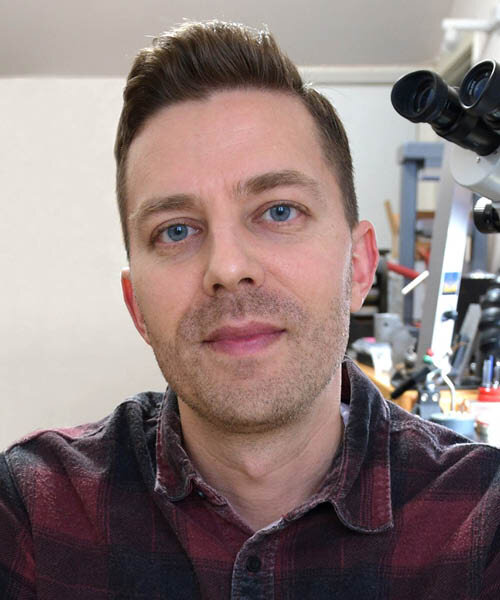Kirk Lang
2nd Place – “Lunares Eclipsim”
When jewelry designer Eddie Sakamoto was asked for his artist statement, he responded: “Keep it simple. Keep it cool.” Six words. Kirk Lang channels a similar philosophy and design sense. Simplicity is a difficult look to capture well but Kirk has done it with such elegance.
Artist Interview:
Q. How did you come up with the title?
The name is Latin-based. It is a scientific convention and relates to astronomy.
Q. What/who was your inspiration?
A lunar eclipse was the inspiration for this piece. I witnessed the total lunar eclipse last year and I wanted to memorialize this magical event by recreating it in metal. It was a wonderful and moving experience.
Q. How long did it take to make the piece?
About a week from preliminary design through completion.
Q. What challenges did you overcome while you were making it?
The challenging part of this particular piece was deciding what material would work best to convey my idea.
Q. What do you plan to do with the piece?
I don’t have any specific plans. It will come back from the award events and it will likely go to Facèré Jewelry Art Gallery, a local gallery that represents my jewelry.
Q. Will this piece inspire other work?
Yes. I feel like every piece I make inspires future work. I look at all my work as a continuum in that way.
Saul Bell Design Award
Q. What did you feel when you learned you’d won?
Pure excitement! This is truly an honor.
Q. Whom did you tell first about winning?
My wife and my one-year-old son. I’m not sure he appreciated it the same way I did.
Educational and Professional Background
Q. Of all the arts and crafts, why did you choose jewelry?
I absolutely love the scale of jewelry and I love metal as a material.
Q. What was the first piece of jewelry you ever made?
I am pretty sure it was a ring I made in high school. It is a little hard to remember because I made a handful of pieces then but gave them all away.
Q. What was your training/academic background in jewelry-making?
2007, MFA, Interdisciplinary Visual Arts, University of Washington, Seattle, WA.
2002, BFA, Jewelry & Metals, Cleveland Institute of Art, Cleveland, OH
(graduated with highest honor).
Q. What was the biggest challenge you have faced in your business?
I think for me it is juggling doing business, teaching workshops around the United States, studio time and time with my family. I am balancing a lot of things.
Q. What other awards, honors have you received in your career?
Last year I won first place in the SBDA's Alternative Metals and Materials category. I was also awarded an Artist Trust Fellowship, Artist Trust GAP Grant and a 4Culture Individual Project Grant. And I was in a show this past summer at the Metal Museum titled 40 under 40: The Next Generation of American Metal Artists.
In 2014 I had a solo exhibition at the National Ornamental Metal Museum in Memphis, Tennessee, and in 2016 I was selected to participate in the Bellevue Arts Museum Biennial titled “Metalmorphosis.”
Q. What is your definition of “success”?
Being happy doing what you do.
Creative Influences and Environment
Q. What or who do you think has been the strongest influence or inspiration on your work?
In terms of subject matter, it would be space and astronomy. I also like technical minimalist design. I don’t really have one specific person or artist who has strongly influenced my jewelry art. That said, my time and experience in my college program was really incredible, as were my professors and peers. My professors provided technical instruction and an ideal environment that allowed me to make my own original work.
Q. What artist, dead or alive, do you most admire? Why?
In terms of jewelry, I can remember being really drawn to John Paul Miller’s work early on. He had a pretty big presence in Cleveland where I grew up. I really admired the subtle and cohesive beauty in his work but also the technical mastery of it.
Q. Do you follow long-term trends? If so, why or why not?
I try not to. I try to follow what inspires me at any given time.
Q. Is the product or the process more important to you? Why?
The process is the most important since that is where all the creativity happens. I find a lot of joy in the process.
Q. What is your favorite tool?
I have a few of those. The microscope at my bench was so important with my Saul Bell entry, as well as my PUK Micro-TIG welder.
Q. What metals, gemstones, processes do you enjoy most?
Metals! I like experimenting with alternative metals such as meteorite or titanium, anything that has not been explored deeply. I also enjoy “play” time when I am not focusing on a specific project and am simply experimenting in the studio.
Q. Describe your studio.
Cozy. European shop feel. It is compact. Everything is at my fingertips.
Interview by Marlene Richey

